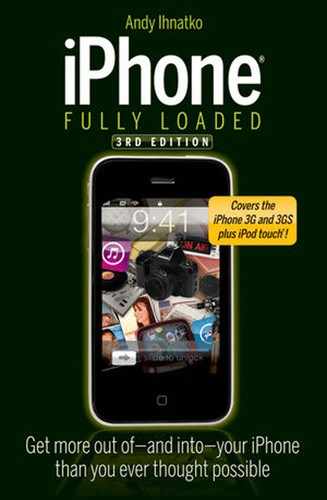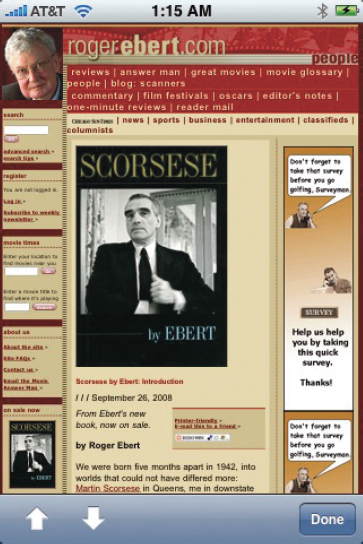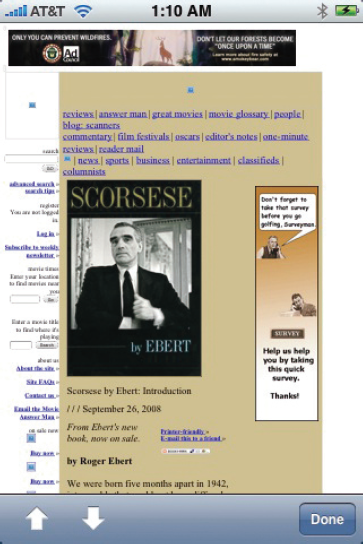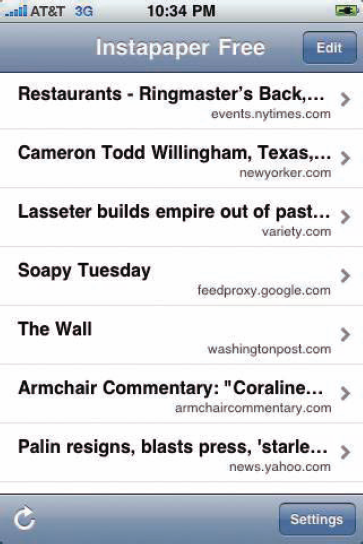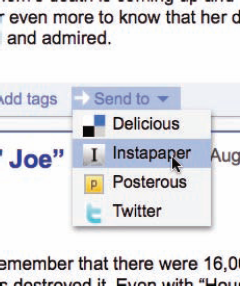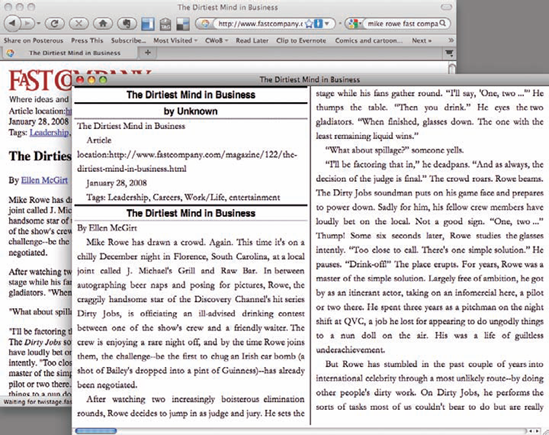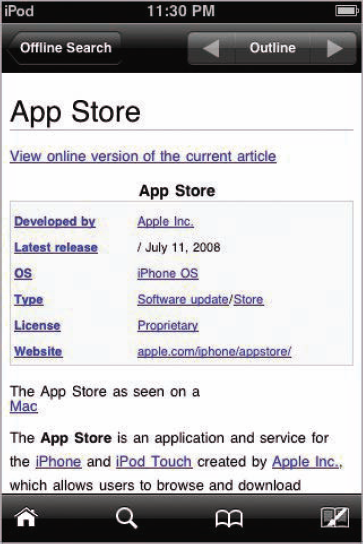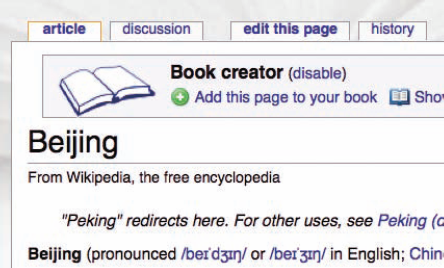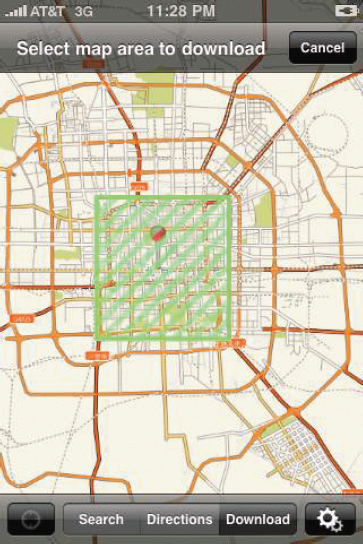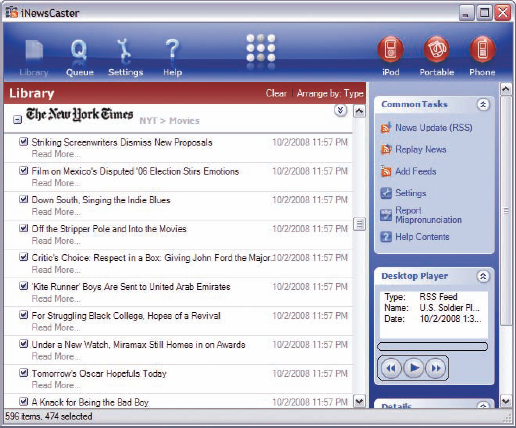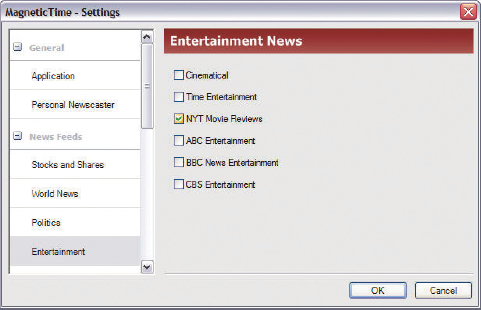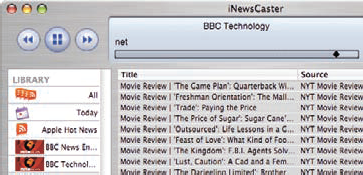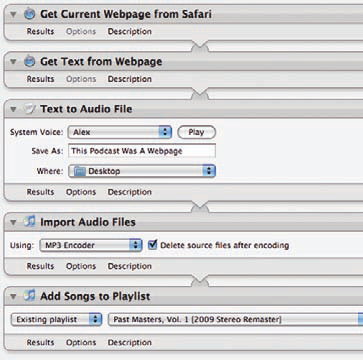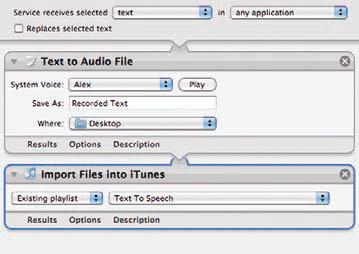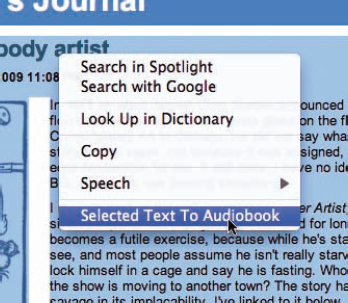The Skim
The Universal "Keep This Info, Please!" Feature
This chapter is allllll about viewing Web pages on your iPhone or iPod Touch.
"The most brilliant and valuable chapter in the whole damned book," you sneer. "Sure, the presence of a Web browser on my iPhone sort of implies that I could open Web pages quite easily, but for the past year, I've been too terrified to click it, suspecting that there was some sort of sorcery involved. Bless you, Andy Ihnatko. You are surely the prominent genius of the iPhone community."
You know, you're a thousand miles away and several months in the future as I write this. Yet your sarcasm still hurts. You know? It still hurts.
Onward. No, of course I'm not talking about just opening Web pages in a browser. I'm talking about keeping the Web pages you want and need, so that you can still read 'em when you're away from an Internet connection. is chapter reveals tools and techniques that take a Web page in your desktop browser and preserves it inside a technological Mason jar on your iPhone, safe from the ravages of Murphy's Law.
You think you don't need these techniques? You've never tried to catch a train at the Amtrak station near my house. The waiting room is a black hole for cell coverage and I need to write down the confirmation number of my reservation in order to use the little self-service kiosk and print my tickets. If it's information that you truly need, then you truly need to save it to your iPhone in some way. The Internet will fail you at the damnedest times.
There are plenty of pages that beg for that sort of treatment. Like the map to the location of your corporate retreat, or an electronic receipt. Hell, you've been to parts of the Web that made you think, "I wish I could stick this page in a Mason jar. With an inch or two of chloroform in it. And then bury it somewhere so that the page couldn't disturb another human being the way that it's just disturbed me."
Well, I can't help you with those kinds of pages. But with the useful kinds ... read on.
This chapter features one indispensable app for storing Web pages on your iPhone permanently. But there's a cheap little trick that you can use to achieve much the same result — and it exploits a feature that comes with your phone.
Much of the time, you don't actually want to save an entire Web page. You're looking at your travel itinerary, and you want to make sure you "keep" the address of your hotel and your confirmation number. You're looking at the train schedules and you want to "keep" the schedule of outbound trains leaving Boston on the Franklin/Forge Park Line. Or maybe it's a quick online bio of the person you'll be meeting with later today, or a section of a Google Map pinpointing the cross-street of your meeting location.
One simple solution is to use the Cut and Paste features that arrived with iPhone OS 3.0. Select the info you want to preserve, copy it, and then paste it into a new note in the Note Pad app.
Good to know. But it's a lot of steps when really, all you want is that seven-digit con-firmation number.
The next time you're looking at a screen full of information that you want to preserve, just hold down your iPhone's Home button and then immediately press the Power button.
You'll hear the sound of a camera shutter and the screen will flash. Congratulations: You've just discovered your iPhone's hidden screen-capture mode. A picture of your screen has been deposited in your iPhone's "camera roll." Just launch the Photos app to view it.
It's instantaneous and it gets the job done — and you'll find a million ways to use this trick.
I spent a couple of weeks in Asia over the summer. Natcherly, I don't speak much Japanese or Mandarin, and the pictograms of those languages are utter gibberish to me. But when some Beijing friends suggested that we meet at Yashow Marketplace for lunch, I just Googled for the name. When I found a Web page with the name of the place written in Mandarin, I zoomed in real nice and took the screen shot.
A day later, I hailed a cab, opened the Photos app, and then showed Figure 15-1 to the cabbie — who took me right there without any ado. In Japan, I used Google Maps to pinpoint my current location. I zoomed in, took a screen shot, and then at the end of the day simply showed my iPhone to the driver I hailed. Because Google Maps always uses the local language, he was able to "read" my marked destination and he brought me right back to the park I had departed from.
Chapter 20 talks about how to install document files on an iPhone. So the first and obvious solution for keeping Web pages permanently is to export the Web page to a file format that the iPhone can read natively. If you can move that file onto your iPhone or iPod Touch using any of the techniques in Chapter 20 — using Dropbox, Air Sharing, or some other utility — the iPhone's built-in reader will open the Web page with just a tap, whether you're online or not.
You're sitting pretty if you use the PC or Mac version of Safari as your desktop browser. is app can export the current Web page in Apple's Web Archive format (choose File
If you're using Firefox or Internet Explorer, you can still export the page as HTML. In Firefox, choose File
Figures 15-2 and 15-3 show the same Web page copied to the iPhone using the Air Sharing utility and viewed with the phone's built-in viewer.
Exporting in some sort of Web-native format is the most convenient solution to the problem. If utter perfect reproduction is required regardless of the browser, export the Web page as a PDF.
Instead of saving a Web page as a Web Archive or as complete HTML files, you can simply use a Print-to-PDF utility to transmogrify the contents of your browser window into a PDF file. All Macs have print-to-PDF hard-wired right into the standard printer driver. Just select Save as PDF from the PDF pop-up menu in the Print dialog box.
Windows machines acquire this sorcerous feature when you make the correct incantation to your Web browser. The incantation is unpronounceable by human lips but when the runes of its bizarre shape are cast, the lines look remarkably like a URL: http://en.pdfforge.org/ pdfcreator, to be specific.
Translated: Download PDFCreator, autil -ity that creates a new Print to PDF printer driver.
Yes? I see a hand up at the back?
"Can't I just do a select-all on the page, copy the text, paste it into a text document, and then put that on my iPhone?"
Yes.
Yes, you could.
You could also wear a plastic clip-on bow tie to a job interview with the FBI.
(A text file! Of all the ...)
Turning a Web page into a file works just fine, but there are multiple steps to creating the file and then you have to undertake additional steps to move it onto your iPhone.
A free iPhone app (available from the App Store, naturally) is the grateful solution to those problems. Instapaper is a free online service that lets you "save" Web pages of interest to a centralized server at www.instapaper.com and then view them later, online or off, at your leisure. Visit the site, sign up for a free account, and then install the Read Later bookmarklet in your bookmarks bar. is bookmarklet is available for all desktop browsers. There's even a version for the iPhone's own Safari browser.
Tip
Yet another advantage of "saving" Web pages onto your iPhone so that you can read them without an Internet connection: Internet access can cost a bloody fortune when you take your iPhone across international borders. By collating and saving all the Web information you'd typically rely on while touring Barcelona, you'll avoid either the $100 that 100 megabytes of data will cost on an international roaming plan, or the much, much, much higher costs that you incur if you use your iPhone overseas without signing up for an international plan in advance.
Tip
No matter which method you use to export a Web page for use on an iPhone, click on the Web page's View on One Page or Printable Version link if there is one. The site will reformat the page so that it prints well; that is to say it'll reformat it so that it looks great when reformatted for the iPhone screen. Plus, you won't have to download a sequence of eight pages to get the whole page or article.
This bookmarklet is the "desktop" half of the magic. Once it's installed, you can copy any Web page to your iPhone by clicking the bookmarklet. The bookmarklet simply passes the URL of the Web page you're viewing over to Instapaper.com, where its contents are preserved.
To download your saved Web pages on your iPhone, launch the Instapaper app and then tap the Update button (see Figure 15-4). All those pages are slurped down into the phone's storage ... safe, sound, and viewable in the app's own text reader (see the example in Figure 15-5).
I love Instapaper. The app integrates perfectly into my "workflow" for reading stuff on the Web. If it's a quick, snappy news article, I'll just read it in my browser. But if it's something long and in-depth, I'll just click the Instapaper bookmarklet and read it later on my iPhone.
And this operation is even smoother if you use Google Reader as your main interface to the blogs, news sites, and Web sites you like to follow. If a certain article left you with a warm, fuzzy feeling and you want to keep it on your iPhone forever and ever, just choose Instapaper from Google Reader's Send pop-up menu at the bottom of the menu (as shown in Figure 15-6). It uses the account information you provided to Reader in its Settings page to hand the URL off to Instapaper, and from there it pushes onward to its inevitable destination on your iPhone.
The "free" edition is, well, free. For a measly stinking five bucks more, you get a "paid" edition that allows you to organize your saved Web pages and offers a slightly more muscular reader. Who cares about the features? Instapaper is an iPhone "must-have" and it's just five dollars. Buy it, and keep Instapaper in business!
Go back to Chapter 9, the chapter on electronic books. Stanza — the finest desk-top and iPhone book reader available — has a nifty little feature: It can convert any Web page, contained in a single URL, into a fairly slick electronic book that can then be read by Stanza's desktop or mobile editions.
It's dead-simple, simpler than what I'd normally use an itemized list for. In Stanza, just choose File
It's good to have both Stanza and Instapa-per in your toolbelt. Stanza creates a much prettier e-book, and its iPhone reader is far, far better than Instapaper's. But Instapaper is much easier to use. Click a bookmarklet and you've got it. Click a menu in Google Reader, and you've got it.
Wikipedia is Google. That's to say that it's become part of the culture of modern humanity and it's seized the role of "online reference tool" that there's really no way any other service will ever come along and challenge it. The information you find on Wikipedia can't be taken as gospel (not even the articles about the Gospels) but to quote a line from the Hitch-Hiker's Guide to the Galaxy, in the places where it's incorrect, at least it's authoritatively incorrect.
So it's good to have a couple of solutions for downloading Wikipedia information to your iPhone where you can be sure it'll always be at hand. If you're curious to find out how to tell a poisonous snake from a non-poisonous snake solely by examining a fresh snake bite, for example, you really don't have time to move to the top of that butte to the north in order to get a better wireless signal. You'll be glad that you loaded up your iPhone with every piece of data you thought you'd need for your week-long badlands adventure.
There's an iPhone app named TiniWiki from mContext (www.tiniwiki.com) and it's utterly barking mad.
Maybe I shouldn't judge. What do you think? It costs $5.99 and it downloads the entire Wikipedia into your iPhone (see Figure 15-8). All 6 million entries. It'll take up nearly 7 gigabytes of storage, but at least if you're ever stuck somewhere without Inter-net access you'll still be able to get all the salient production details about the Happy Days spin-off Joanie Loves Chachi.
See? You agree with me: barking mad!
But cool. Awesome, even. And it seems just a tad more sane when you learn that you have the option of just downloading certain "volumes" of the Wikipedia instead of the whole trough. And for six bucks, it's a hell of a wonderful little novelty app, with the added bonus of maybe providing you with exactly the info you need in an isolated situation.
And it's not insane to want to carry parts of the Wikipedia with you. I bring you back to my tales of adventure in Asia. I had an iPhone in my pocket and as such, answers to pressing questions ("If I eat something called a 'Hundred-Day-Old Egg,' will I quite simply die? Or is it just one of those colorful names?") were within reach. For a price. Remember, using the Internet outside of your home country costs beaucoup bucks.
Under those terms, TiniWiki is a neat idea, even if it can eat up fully half of your iPhone's storage. Besides, TiniWiki lets me live that dream I had since the first time I read Douglas Adams's the Hitch-Hiker's Guide to the Galaxy as a kid: My iPhone is an electronic device that contains every scrap of knowledge ever compiled.
Mine's even better than the device in the book: It also plays music and video.
If you want to carry Wikipedia content around with you, you might also try out one of Wikipedia's under-used feature: the ability to make "collections" of articles. Look at a small panel of buttons in the left gutter of any ' article, entitled Print/Export, Click the Create a Book link and after a one-click setup, a new toolbar appears atop every Wikipedia article you read (see Figure 15-9).
So if you're preparing for a trip to Beijing, just browse through all the tourism, history, social, and political articles that strike your fancy and click the Add is Page to Your Book button in the toolbar. When you've had your fill, the site can export all of your collected articles into a single, downloadable document:
Click the toolbar's Show Book button. Wikipedia will take you to a new page that shows your collection of articles.
Drag and drop items in the list of articles to change their order, and give your book a title.
From the Download box on the same page, choose a document format from the pop-up menu. PDF should be self-explanatory at this stage. The Open-Document Text option will save it as a nicely formatted (and highly reformattable) word processing document.
Click the Download button. Wikipe-dia will crunch the articles for a minute or two and then furnish you with a link you can click to download your collection.
You can use the PDF file as is with any of the "slap it on your iPhone and read it" solutions Imention in Chapter 20. OpenDocu-ment is a new-ish word processing format favored by Wikipedia because it's an open format owned by no one company. Most modern word processors can import the file. You can export your Wikipedia book into a Microsoft Word-compatible file and then hand it off to Stanza for further e-book transmogrification and final installation onto your iPhone.
"Good God, sir!" you exclaim. "I have the Google Maps app! Why the devil would I want to carry copies of maps stored on my iPhone!"
Here I cross my arms and patiently wait. You blink once or twice and then feel some small embarrassment.
"You're about to tell me 'What if you're in a foreign country,' right?"
Yes, how perceptive of you. Map data is still data. Lots of data. Because don't forget that Google Maps is always downloading map information as you go. Plus, although GPS covers the entire planet, it's a fatal mistake to simply assume that your iPhone will be able to find a cell tower no matter where you walk or drive.
The App Store is now bursting with apps that download entire regional road atlases to your iPhone and offer you turn-by-turn spoken directions from point a to point B. And they get the job done but actually, I'm here to tell you about an extremely little nifty app called OffMaps (www.offmaps.com) by Felix Lamouroux. It's just $2.99.
Let's go back to Beijing, since it's done so well for us throughout this chapter. As you prepare for your trip (or via the free Wi-Fi at the Raffles Hotel lobby near Tianan-men Square), type "Beijing" into the app's search box. It'll center its map at the city or address you specified.
Now, you can download any map region you desire. Just tap the Download button and draw a square around the region (see Figure 15-10). OffMaps will download every last scrap of map data and install it on your phone.
Presto. OffMaps acts as a replacement for the Google Maps app (aping its basic "where am I/track my movements" feature), plus it adds a boatload of neat location-specific tweaks as well. What's interesting nearby? OffMaps will pull up relevant Wikipedia articles about your location.
OffMaps works because it doesn't use Google Maps' licensed data at all. Instead, it downloads its maps from OpenStreetMaps. That's sort of the Wikipedia of mapping data. It's free to everybody, and because the public is encouraged to enhance the data with information about nearby restaurants and services, it tends to have even more information than Google can provide.
But what if you're not in the mood for using your eyeballs today? Meaning: You're acting all petulant because of a perceived slight that your eyes made over the breakfast table. Or maybe it's just that you're driving and you want to listen to blog posts for a half hour instead of reading them and killing many, many people.
Magnetic Time (www.magnetictime.com) has a nifty product for both PCs and Macs. iNewsCaster is an RSS reader that works like any other newsreader app ... up to a point. As for the apps I cover in Chapter 13, you just provide the app with the URLs to the syndication feeds of your favorite blogs and news sites and it automatically downloads and presents all the new, unread articles for your pleasure.
Decidedly unlike the others, iNewsCaster actually reads the articles into an iPhone-compatible sound file, using a soothingly natural synthetic voice.
It's 30 bucks, but you can download a free trial to see how well the thing works for you.
Figure 15-11 shows iNewsCaster's main window. As you can see, the app has been busy, grabbing headlines from a bunch of different sources.
You can add sites to iNewsCaster's watchlist with just a few clicks:
Click the Add Feeds button, located in the Common Tasks pane of the main window. iNews-Caster's Settings window opens (shown in Figure 15-12).
Scroll the pane on the left until you see the News Feeds section. A number of popular newsfeeds are built right in, organized by category. Just click the checkbox of any feed that you'd like iNews-Caster to keep an eye on.
You can also add the feeds of your favorite sites and blogs manually. To do that, scroll the list down to the very last item and click on Custom Feeds.
Click the Add button. A dialog box appears.
Paste the URL to your favorite site's newsfeed into the dialog and click OK. (see Figure 15-13). Repeat for each of your custom sites and blogs. Turn once again to Chapters 13 and 14 for tips on how to locate the URL for a site's newsfeed. iNewsCaster automatically checks each of your subscribed feeds for new content, and downloads any fresh articles it finds.
When you want to convert these articles to spoken audio files:
The Mac version of iNewsCaster operates in nearly the same way as the Windows edition. The layout of the buttons is just a little bit different (see Figure 15-14).
No matter which app you use, the result is the same: a pile of very natural-sounding spoken-text files in iTunes, ready to be synced to your iPhone or iPod Touch.
The files are automatically added to a new playlist in iTunes called iNewsCaster the app also identifies the tracks' artist as iNewsCaster, so it's easy to build smart playlists (see Chapter 1) that automatically load just (for example) the most recent 10 converted tracks that have a running time of more than five minutes.
If you're using a Mac, there's a simple solution that falls short of iNewsCaster in just one regard (it won't automatically make audiobooks of new Web articles as they're published) but superior in two others (it offers point-and-shoot simplicity and it's free). Just create an Automator workflow that converts the current Safari Web page into an audiobook.
It's much simpler than it sounds.
Launch the Automator app and create a new workflow.
Build the workflow you see in Figure 15-15. You create a workflow by dragging actions from the list on the left side of the Automator window into the right side of the window. To locate each of these individual actions in the Actions library, just type their names into the Search box. Automator will locate them for you.
Just to keep yourself sane, I've added that final step to the workflow: Instead of slapping these audiobooks into the library where they'll get lost, add the new audio file to a specific playlist. Choose a playlist from the pop-up menu. Maybe you'll want to create a new one just for this content.
Try it out. Open up a Web page in Safari — something with just a little text, like the Safari home page — then switch back to Automator and click the Play button. In a few seconds, you should hear a cheerful beep indicating that everything worked fine. Go to iTunes and play the audiofile ... it'll be named " is podcast was a Web page" or whatever you chose to put into the Text To Audio File action.
If it all worked fine, choose File

Give this workflow a name (such as "Convert this Web page to an audio-book") and choose Script Menu from the Plug In For pop-up menu.
Your automatic workflow will appear in a script menu alongside the Safari menu. Just select the workflow from the pop-up whenever you're looking at a Web page that demands the audiobook treatment.
If you're using Mac OS X 10.6 Snow Leopard, you can go one better: Instead of using a tool for converting Safari text, you can create a service so that any text anywhere in any application can be quickly converted to audio and added to iTunes. Here's how:
In Automator, create a new workflow and select the Service template.
Build the workflow you see in Figure 15-16.
Save and name it. How about "Selected text to audiobook"?
From now on, you can convert any text in any window in any Mac app to an audiobook. Just highlight the text and Control+click or right-click to bring up the contextual menu (see Figure 15-17). Choose the Automator workflow, and the magic happens.
One word of warning: It can take a few minutes for Automator to convert a particularly long article to text. Yeah, that's why I had you open the Google home page when testing this out.
When I was a wee lad, the people who were running the Internet were fond of screaming "Information wants to be free !" in between shoveling double-handfuls of granola and hemp dental floss into their mouths.
Well, I'm of a later generation. I have absolutely no problems incarcerating data and depriving it of its liberty. Its family members may petition the governor as much as they please, but my heart is forever barred against sympathy.
Because (dangit) I've been stuck in an airport with no bars on my cell phone and nothing to read. I will not let that happen again. And so long as I'm diligent about saving or Instapapering anything I read online that's halfway interesting, I'll never go hungry again.
